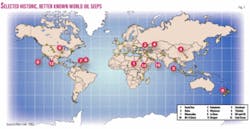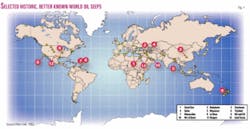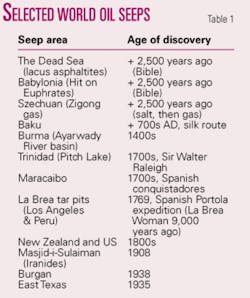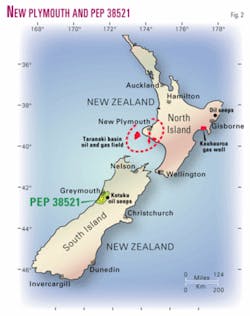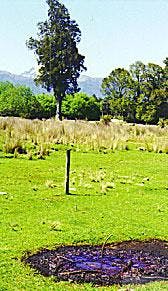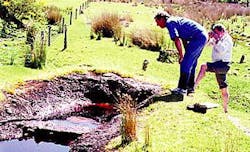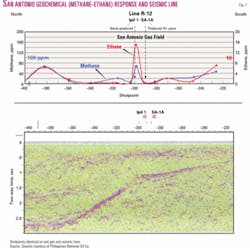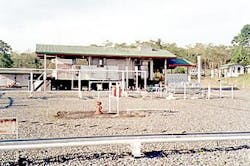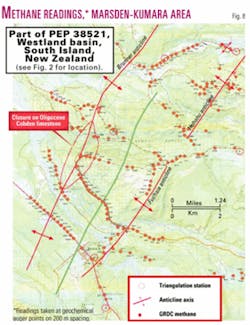This article is a quick review of a few selected world oil seeps and surface geochemical techniques and methods used to detect seeps not visible to the eye (microseeps).
Information is presented concerning use of surface geochemical methods and the economics of small-scale gas resources and their importance. The small-scale accumulations can be explored for by surface geochemical methods.
Geochemical and geophysical effects and changes occur in rocks that overlie subsurface hydrocarbon accumulations by virtue of hydrocarbons migrating to the surface from such accumulations. Information is presented on the types of changes, rates of migration, and methods being used to detect such effects.
The art of interpreting the data based on case histories, geological considerations, and experience is the critical element of surface geochemical exploration. The question, as Hedberg put it, is not whether the data are valid but rather what the data are telling us and at what cost.1
References and examples of predrilling geochemical interpretation of prospects developed by seismic, subsurface, and other methods, are given herein to provide estimates of the success rates of geochemical predictions.
Economic benefits can accrue from the discovery of small-scale gas deposits used to generate electricity. This is based on a ten-year bench model in the Philippines and projected to show how it might benefit New Zealand.
The surface geochemical method and program being used by the operators of PEP 38521 on South Island is illustrated. This can be applied to almost any part of the world with infrastructure and a market for electricity.
World megaseeps
A place where oil, gas, tar, or pitch are leaking on to the surface of the earth and are plainly visible to the eye is considered a megaseep.
Over 50 years ago, Walter Link, then chief geologist for Standard Oil Co. (New Jersey), used that entity’s worldwide files to compile all the oil seeps known at that time2 (Fig. 1).
Megaseeps circumscribe the globe and occur in nearly every oil producing region. Literally hundreds have been found. For the purpose of this article, a few have been selected based on their recognition and history of discovery through time and space (Table 1).
Link noted about five types of seeps relative to geology, which included the ends of homoclinal outcrops; folds, faults, and eroded reservoirs; crushed source rocks in major fault zones; unconformity related seeps; and intrusion related (salt, igneous, mud) seeps.
In the late 1800s and early 1900s in California, some 57 oil fields including some of the larger onshore fields in the US were discovered as an outgrowth of pursuing surface oil seeps.
Not all megaseeps have led to discoveries of oil or gas fields. In general, a seep demonstrates the presence of a petroleum system in any given area or region.
Some of the seeps selected here have been related to large accumulations, such as Burgan, Masjid-i-Sulaiman, and East Texas. In some instances however, such as the Sirte basin in Libya, there are no megaseeps and yet major oil fields are present (e.g., Sarir).
To date in New Zealand for example, no significant discovery has been associated with the Kotuku seeps on South Island, which are some of the finest visible seeps to be seen anywhere (Figs. 2 and 3a-3b).
Maybe more exploration work is needed in the Westland basin? It is perhaps of interest to note, though, that on North Island, seeps in the vicinity of New Plymouth in the Taranaki basin (New Zealand’s only producing basin to date) were the cause of drilling in the 1860s concurrent with the Drake well and developments in Pennsylvania.
Surface geochemistry
Surface geochemistry as applied to oil and gas exploration is the search for surface and near surface direct indications of the microseepage of hydrocarbons or secondary effects and alterations that migrating hydrocarbons leave as a trail to their having passed through the rock column above a subsurface accumulation.
One is looking for seepages so small that they are invisible to the eye and must be detected by chemical or geophysical methods.
The basic tenets that must be accepted are that there is no such thing as a perfect seal and that hydrocarbons will rise vertically through a rock column. It is true that migration can occur along some fault planes and possibly laterally up a dip slope. Such migrations leave a distinctive surface pattern that can be identified. Vertical migration above an accumulation will be dominant.
If these things are accepted, then one can move from the position of a heretic about surface geochemistry (which this author was after 50 years of “shoot and drill on four-way dip closures as the only way to go”).
After study of the tomes of technical reports and case histories that have been written by dozens of dedicated scientists over the past 30 years (see AAPG Memoir 66 and AAPG Studies in Geology No. 48)3 4...the movement to becoming a skeptic is logical...but eventually the seasoned explorer with an open mind will likely become an advocate of using surface geochemistry, at least in conjunction with other tools. It is not necessarily the only answer.
The direct and indirect effects of hydrocarbon migration through a column of rock are often presented as a diagram of the so-called “geochemical chimney” (Fig. 4).3
Data acquisition
In general there are two approaches to obtaining geochemical data.
There are methods that look for direct indications of hydrocarbons and there are methods employed to find indirect evidence of the presence of hydrocarbons.
Seeking direct indications is one method often used by current operators. This is the method being used currently by operators in the Westland basin of New Zealand.
The method being used in Westland for direct detection involves collecting samples from a depth of 1 m and preserving them for analysis in the laboratory. There they are broken down, and released free gas in the sample jars can be detected with chromatographic instrumentation.
The objective is to find traces of methane, ethane, butane, and propane and determinations of the Eh, pH, conductivity, and other parameters of the sample.
Direct detection
The direct detection methods being used at present in the industry include:
1. Hydrocarbon gas in samples obtained from depths of around 1 m;
2. Ball milling of cores from shallow depths to release hydrocarbon traces;
3. Chemical absorption probes; and
4. Direct chromatographic readings in deeper holes (2 m +).
Indirect detection
Analysis by chemical means to study effects in the suspected geochemical chimney):
1. Reduction and oxidation effects (Eh)...provides apical anomalies
2. Acidity-alkalinity effects (pH)... provides halo anomalies
3. Organic-inorganic salts (halides)...conductivity anomalies
4. Iodine and microbial analyses.
5. Spectral effects (bleaching of certain areas).
Geophysical detection
This is not discussed here but relates to magnetic, gravity, and radiation anomalies that can also be induced into the rocks of the geochemical chimney by microseepage.
Success rates
Numerous industry studies over large samples of prospects that were developed by seismic, surface, and subsurface means demonstrate the efficiency of geochemical analysis of a prospect before drilling.
Such prospects that had geochemical surveys before drilling could have either a positive geochemical anomaly or a negative geochemical anomaly. Those prospects that have positive anomalies will have a greater chance of success. Those with negative anomalies will nearly always be dry holes.
Several cases are cited in the AAPG references provided at the conclusion of this article. Two of the significant studies are those of Santa Fe Minerals for 159 prospects in the US and overseas5 and that of Thomasson and Leaver6 for 89 prospects in the US.
For example, the quoted Santa Fe study of 139 prospects led to the drilling of 141 wells. Of these 43 were drilled on prospects with negative geochemical anomalies and 41 of these encountered no hydrocarbons. Ninety-eight wells were drilled on prospects with positive geochemical anomalies resulting in 37 commercial successes.
The Thomasson and Leaver study using the iodine method, demonstrated that overall from their 89 prospects, 32 producers were found. Of these, positive geochemistry anomalies had indicated 27 of these would be productive. Of the 57 dry holes, the iodine method predicted 53 of them would be failures.
In general, geochemical surveys are a good screening test for prospects developed by seismic or other methods. It appears that a negative anomaly will nearly assure a 90-98% failure rate. Areas with positive anomalies have success rates of 30-50% as commercial finds. Geochemical success can be higher, often around 90%, but that in itself does not assure a commercial find.
Vertical migration rates
An interesting aspect of the literature studies reveals the proof and also the rates of vertical migration of hydrocarbons from a subsurface accumulation to the surface.
These data have generally accrued from secondary recovery studies or gas storage projects where surveys taken over periods of time demonstrate hydrocarbon effects at the surface changing as a result of gas or fluid injection at depth. Some of these rates described for example, are as follows:
1. Wyoming, Patrick Draw field, 200-1,000 ft/year.
2. West Texas, 0.6-2.0 m/day.
3. Iowa, Keota Dome gas storage, 5 months to change surface mapping patterns following injection at 2,200 ft.
Some economic aspects
Shallow gas from small accumulations, less than say 15 bcf, can be significant financially if used to generate electricity and can be found in areas where infrastructure and demand exist.
Geochemistry can be used to explore for such deposits or to upgrade prospects of these smaller magnitudes because of the cost factor, relative to say trying to use a full-scale seismic survey to define a smaller prospect and still not know whether it has a possible hydrocarbon accumulation.
The more expensive, conventional methods will blow the economics of looking for small-scale deposits. Geochemistry has a role.
Philippine bench model
Playing off a “noncommercial gas discovery” in 1959 by Stanvac near the Ipil-1 well in the Cagayan Valley of Northeast Luzon (Fig. 5), Philippine National Oil Co. has proven the economic viability of producing a small gas field to generate electricity.
PNOC placed its San Antonio 1-A (an offset to the Ipil 1) on stream in 1992 at 1 MMcfd through a 3-Mw generator (Figs. 6 and 7). It is now more than 10 years old. The field was determined to have only a 4 bcf reserve to start and today still has about 1.8 bcf to produce.
One needs only to follow the math to see how it is possible. In the end it relates to the price per kilowatt-hour of electricity sold. Economically, this might work well in New Zealand or in other parts of the world.
It is noted that a household consumer in Manila is paying about 8.63 Philippine pesos/kw-hr (0.21 NZD). However, in the field, a local cooperative is paying PNOC about 3.92 PhP/kw-hr (Table 2).
So, 7.3 PhP at 54p/US dollar works out to $135,200/month gross revenue.
In another example, the consumer in Greymouth, NZ is paying 0.11-0.17 NZD depending on the rate and load (Fig. 2). A 3-Mw gas-fired generator at Brunner anticline east of Greymouth should provide a profitable opportunity.
An operator at a facility, if successful, on Brunner anticline might generate monthly cash flow almost comparable to that of the Philippine bench model. This depends on the price that the generator can obtain from the distributor or consumer.
Natural gas will easily compete with any other fuel that might be used locally to establish some other type of generator (coal, diesel, etc.).
In the Philippines where diesel and fuel oil are the popular fuels for barge generators, etc., it currently costs about 2.81 PhP/kw-hr of electricity generated using diesel, according to figures from National Power Corp. On an energy equivalent basis, this would equate to natural gas selling at about $15 (US)/Mcf.
Only $4 (US)/Mcf would likely generate a good return on capital for a small gas field, hence there is “room to play” if the gas can be discovered.
Outlook
Surface geochemistry provides a valid and cost-effective tool to use in the search for valuable, small-scale gas resources in areas where it can be converted and sold as electricity.
The Westland basin in New Zealand appears to be a place where this method can be used to pursue existing information of oil and gas shows. The SFL-1 well on the Brunner anticline had a limited test flow 6.5 MMcfd of gas in 1942.
A pioneering methane-propane geochemical survey over structures in the Paounamu deep; east of the Marsden-Kumara trend,7 and shows on the east limb of the Grey Valley half-graben (Niagara-1 and the Kotuku seeps); reconnaissance seismic information, and fairly extensive surface geological mapping suggest other prospects might be found. The November 2004 auger geochemical survey’s methane results are very encouraging (Fig. 8).
Surface geochemistry also looks to be the weapon of choice for exploration in several other parts of the onshore Philippines when used in conjunction with older seismic data, shows in wells drilled years ago, or other leads. ✦
References
1.
Hedberg, Hollis R., 1981, in introduction to AAPG Memoir 66, 1994.
2. Link, Walter, "Significance of Oil and Gas Seeps in World Oil Exploration," AAPG Bull., Vol. 36, No. 8, 1952, pp. 1,505-40.
3. Schumacher, Dietmar, and Abrams, Michael, "Hydrocarbon Migration and its Near Surface Expression," AAPG Memoir 66, 1994. 4. Schumacher, Dietmar, and LeSchack, Leonard, "Surface Exploration Case Histories,"; AAPG Studies in Geology No. 48, 2002. 5. Potter, R.W., II, et al., "Significance of Geochemical Anomalies in Hydrocarbon Exploration: One Company's Experience," in Schumacher, D., and Abrams, M.A., eds., "Hydrocarbon Migration and its Near Surface Expression," AAPG Memoir 66, 1994, pp. 431-439. 6. Thomasson, M.R., and Leaver, J.S., “Case Studies Relating Soil-Iodine Geochemistry to Subsequent Drilling Results,” in Schumacher, D., and LeSchack, L.A., eds., AAPG Studies in Geology No. 48, 2002, pp. 41-57. 7. Suggate, R.P, and Waight, T.E.,";Geology of the Kumara-Moana Area,"; New Zealand Institute of Geological & Nuclear Sciences, 1999, 124 p.The author
Ed Durkee ([email protected]) is a senior exploration geologist and consultant residing in Manila, Philippines. With a wide-ranging background in international exploration, his first assignment to the Philippines was in 1956. Maintaining an interest there ever since, he has been a resident since 1993. Handling assignments throughout Southeast Asia and Australasia he has been involved in the application of surface geochemical methods to exploration in the Philippines since 1999 and more recently in New Zealand, 2004 to present. His geochemical applications have been in conjunction with Gallagher Research & Development Corp., Lakewood, Colo. He has a BS and MA in geology from the University of Wyoming.
